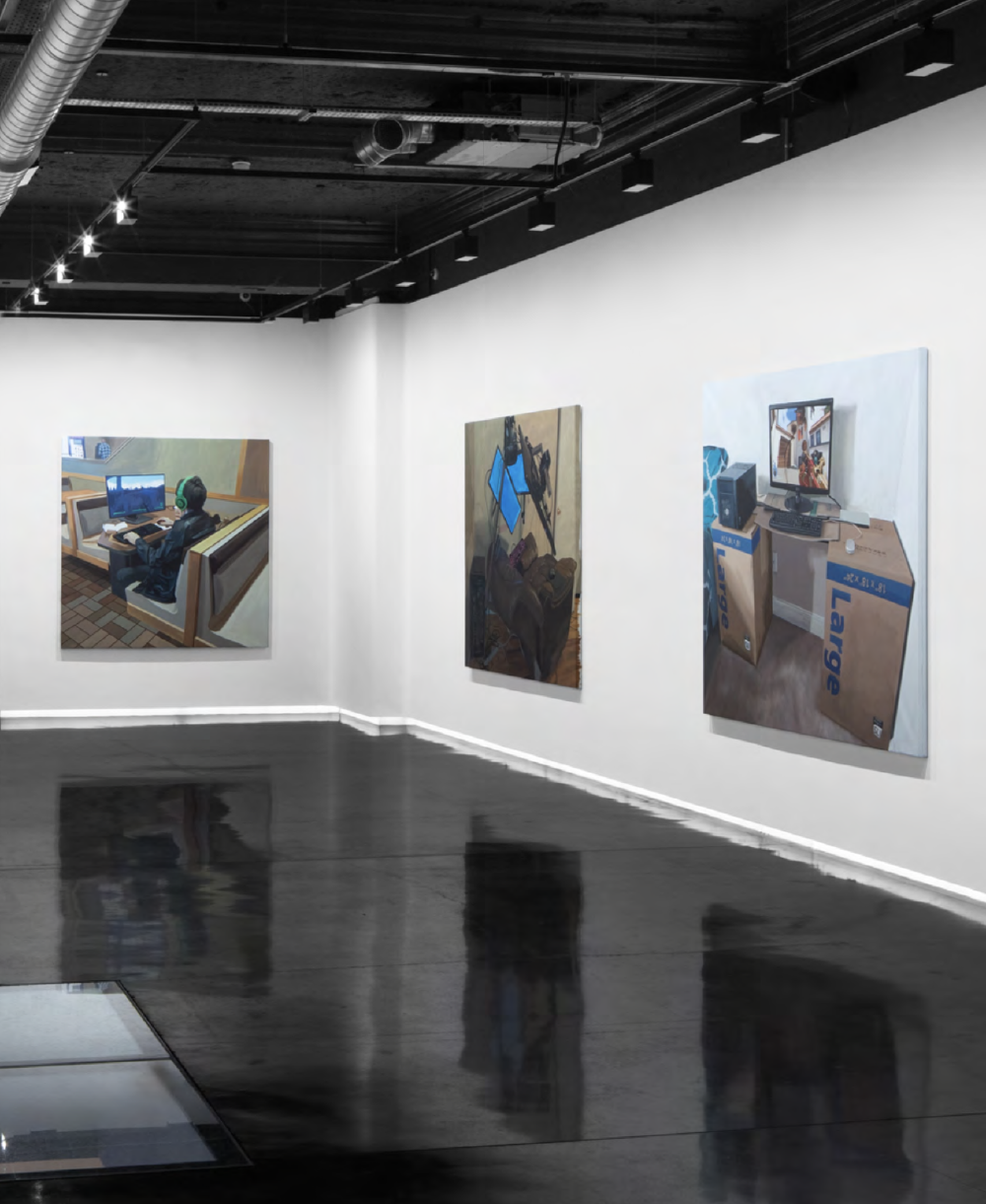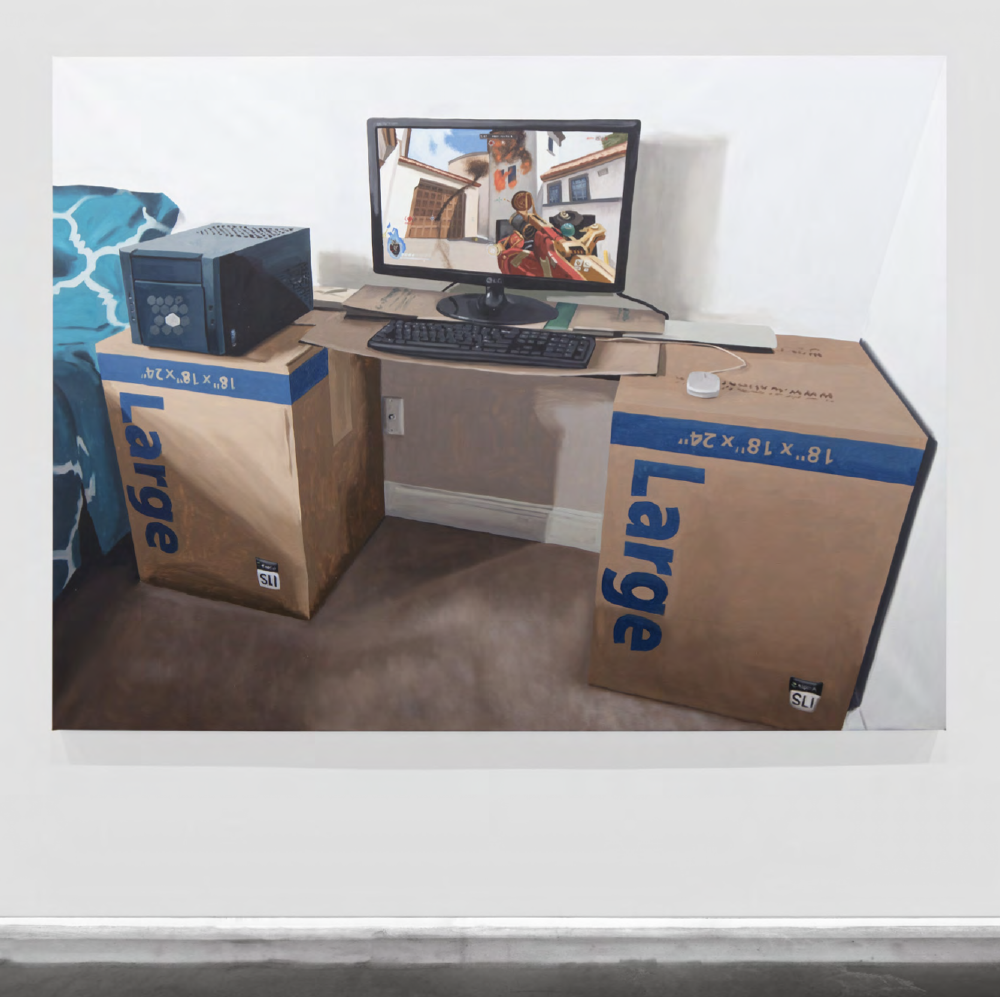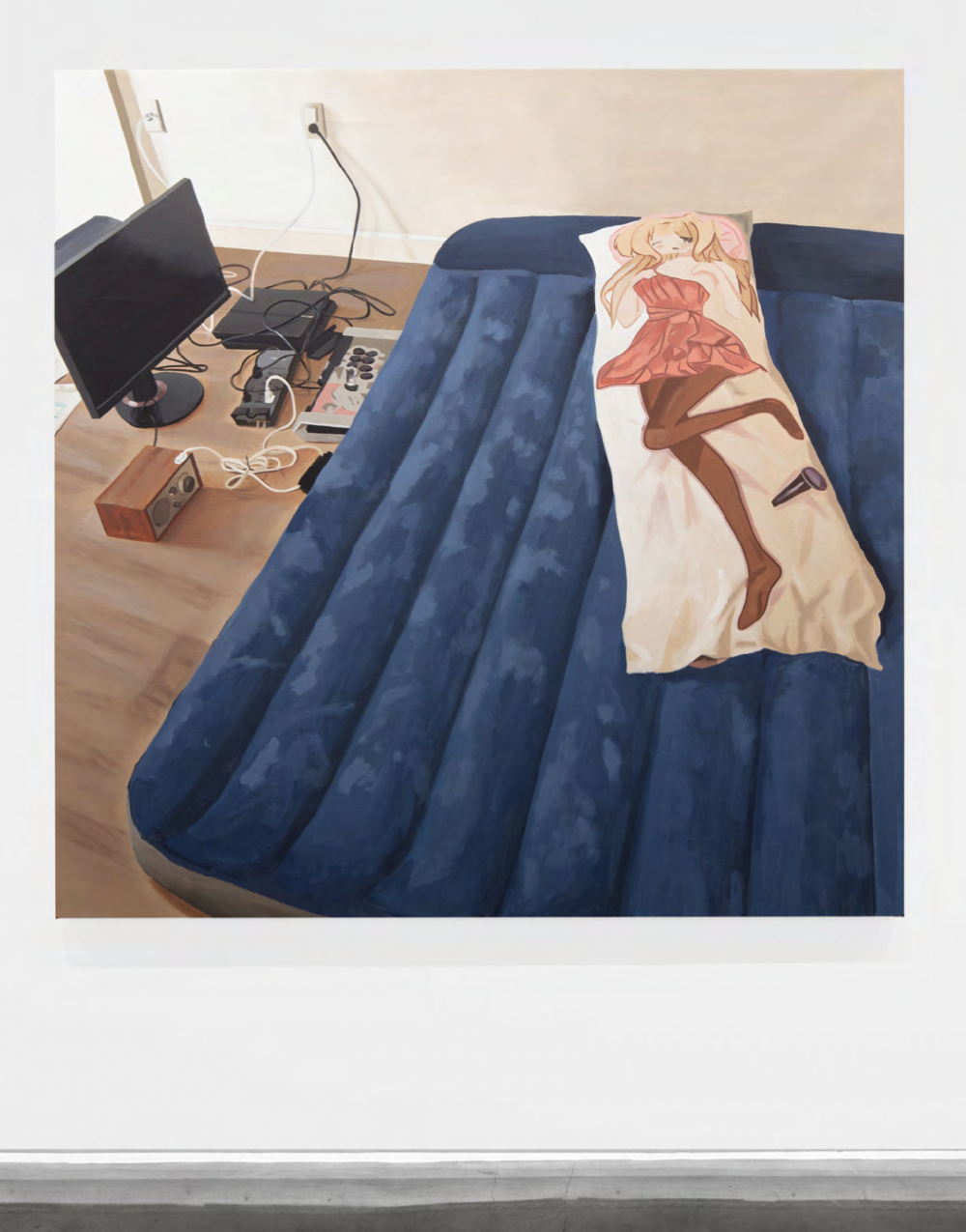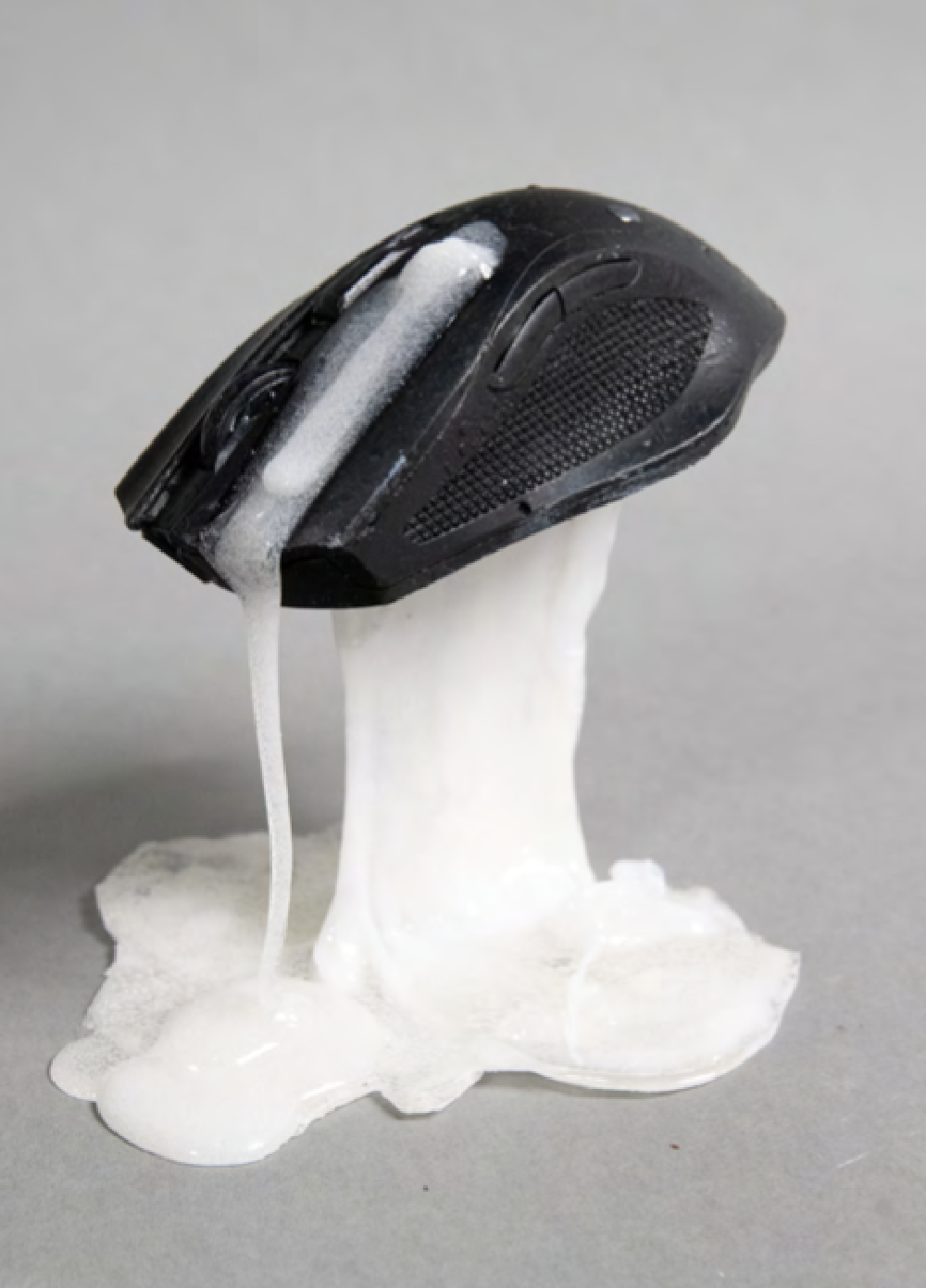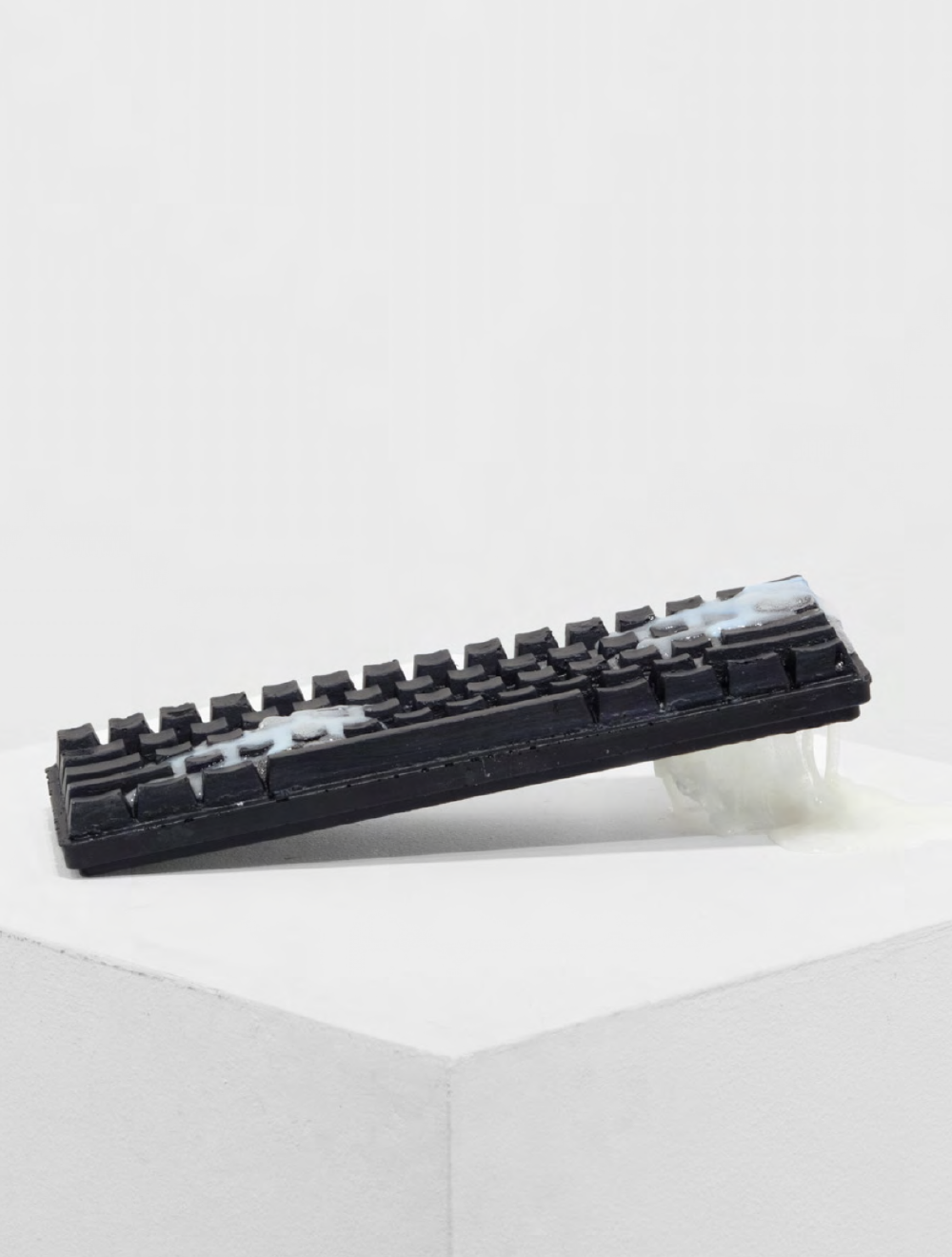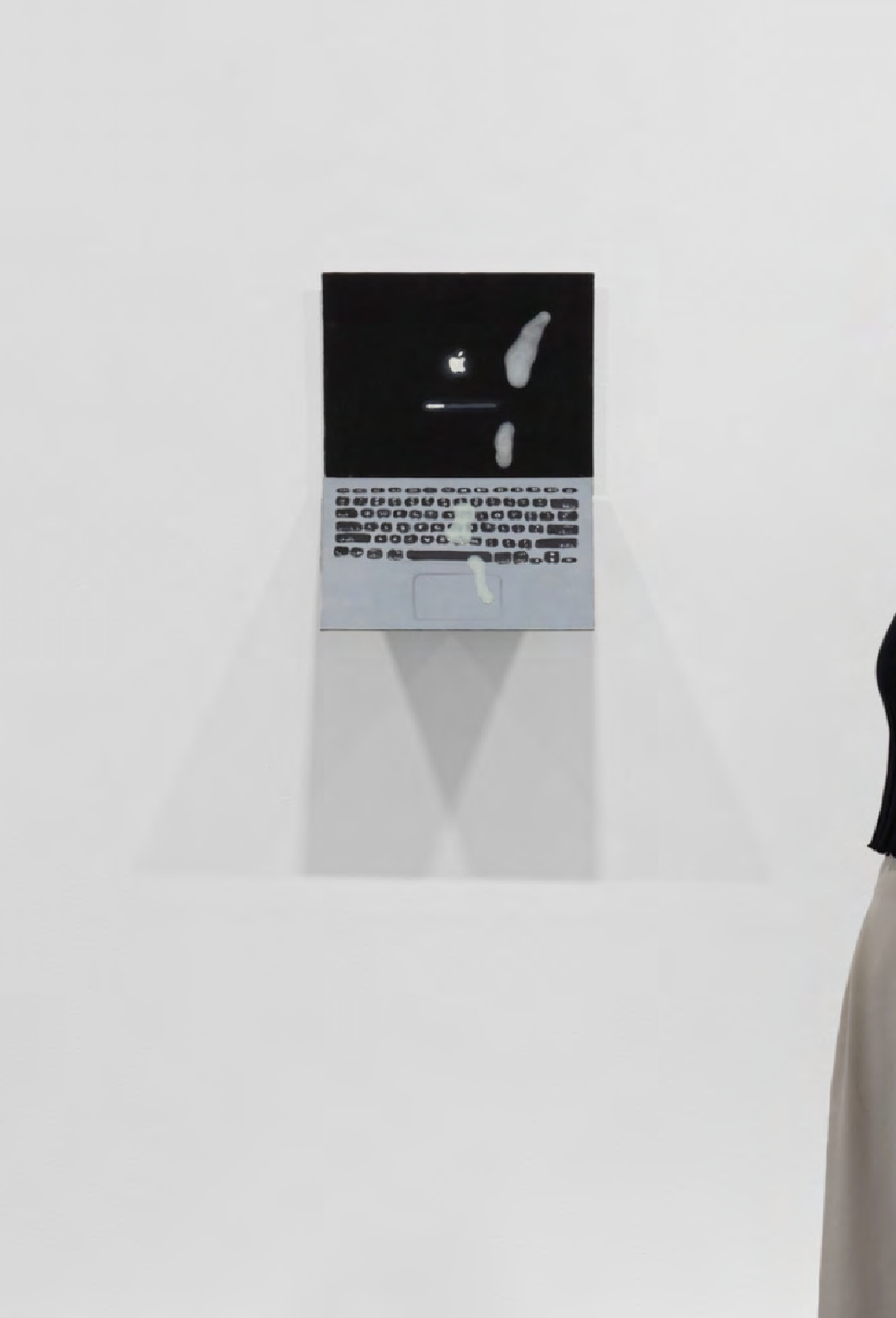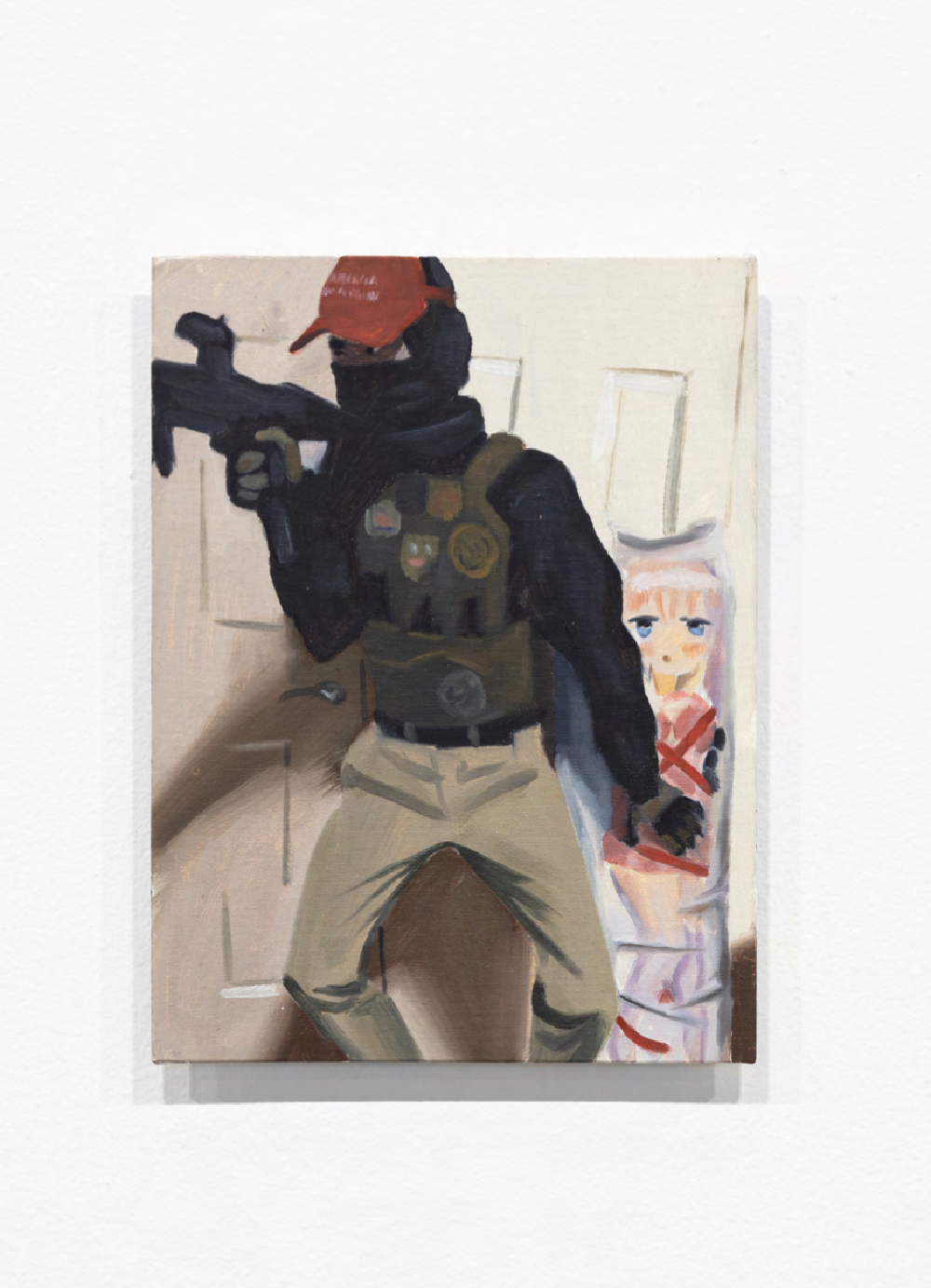Mauro C. Martinez @ Unit London
GDLP
Emoji summary: 💻⌨️💦
I turned up to Unit London hot and bothered. Dungarees slipping, glasses fogging up. My phone was running out. The usual. There were no benches on the beige curve of Regent St on the walk up to the gallery, only Uniqlos, a police presence, and these terrible planters with thin edges and angled sides for anti-homeless, anti-disabled, anti-happy architecture. London can be so hard. I was on my way to see an exhibition by Mauro C. Martinez, an artist whose work I’ve only ever seen online, at a gallery I’ve only seen in install shots. In the twenty minutes it took to walk there, I listened to the beginning of an interview Martinez did with the Artist Decoded YouTube channel. I’m hot and bothered when I reach the show because of disability and because of the conversation I’ve just listened to.
In the summer of 2020, Martinez painted the murder of George Floyd. He posted the image of his painting less than a week after it happened. In it, he overlaid the scene with Instagram’s flagging system. George Floyd, the police officer, the car, road, knee, all of the content was blurred beneath a sharp screen-print UI that read ‘This photo contains sensitive content which some people may find offensive or disturbing. See Photo.’ But in painting form, it meant you couldn’t click to reveal anything.
Many people were furious, and the comments were livid. Many criticised Martinez for capitalising on Black trauma; he is a prolific price-on-request kind of artist with international gallery representation, so it was fair to bring cultural capital into the discussion. Uncomfortable to think about who might want to buy something like this if he were to put it up for sale; and even if he didn’t make the painting available out of respect, what would the ‘all press is good press’ effect do to his wider value as an artist? It was brazen. It didn’t feel like an appropriate (or viable) time to academically, critically approach a conversation on censorship through the medium of painting. A Black man had been murdered once again by an immovable white institution, and Martinez’s input to the conversation didn’t feel particularly historical; the artist came off like an opportunist riding trending tweets when non-Black people were being asked to shut up and listen, for once. Martinez carried on.
His response was fascinatingly awkward. Many people commented that he was wrong for making this work because he is a white artist, not knowing that Martinez isn’t white. The artist ran with this mistake and posted a carousel on Instagram that included the back of his most recent painting, screenshots of comments that labelled him white with the white part underlined in red, a smiling picture of himself, a border force interaction, and a police dog coming towards a car to complete his defence. In the caption, Martinez made the case that he is hispanic, his hometown is in Texas, and he was once detained for a day in Mexico when trying to cross back into the US. The criticism continued. It didn’t wholly matter that Martinez wasn’t white, or that he had experienced some instance of institutional racism; it mattered that he wasn’t Black; it mattered that he was still speaking. It’s worth noting that Unit London, the gallery I was heading towards for the new exhibition, had commented four white clapping hand emojis under this second post. Four white clapping hands.
The artist is an interesting god-like figure who can make anything in the world the subject of their work. The artist exists as a slippery figure who can sidestep criticism, and redirect it away from themselves and to the subject itself. Because if audiences aren’t happy about subjectification, no worries – the artist can hold the work at arm’s length and ask us to think what our discomfort indicates. Isn’t it interesting? Isn’t it good that the artist can make us think? Clever boy! The spar between artist and audience in this example is excruciating; any negative reaction to Martinez’s Sensitive Content series becomes reframed as a sensitive overreaction, and a false threat to censorship that actually fulfils his prophecy and subject matter. Critique makes the artist look prescient, thought-provoking and wise instead of cunning, sly, or even colonising; he can paint whatever he wants if he stands back once he’s done and tells us that he is just thinking about what it means to paint anything at all, no big deal.
This is the defence of the edgelord artist, and it makes me feel uncomfortable to the same degree I feel bored when right-wing voices call their critics snowflakes. You know, the audience simply isn’t built for what these strong men have to say and the ‘truth bombs’ they have to drop. It’s got nothing to do with the audience fundamentally disagreeing with what truth means, or what truth should mean. It’s boring, it’s boring, and it’s embarrassing too. In my experience, when someone goes on and on about free speech, it usually means they do not like to hear a word of criticism. I am thinking about that now while I make my way through this review. I would like to also just generally note that Unit London did an exhibition in 2022 about free speech in art; and that when Martinez posted screenshots of comments calling him white, he only underlined the part of the comment calling him white, and not the rest of the free critique he was being given. I wonder what he’ll underline in this one.
In the Artist Decoded Interview, which was published in April 2021, Martinez was asked to reflect on the moment he painted George Floyd. He said, ‘My goal as an artist — and I consider it the highest honour — is to just document what’s happening, and to that end, I think that’s why it’s important to be as ideologically clean as you can, and be without agenda, and be somebody who just listens to what is happening and doesn’t respond with ego or anything like that. Then you can present a balanced statement that’s not polarising and is filled with the nuance that we need today, that we’re severely lacking.’ The phrase ‘ideologically clean’ is worth repeating, and thinking about, and damning. There are many different kinds of artists in the world and this one wants to exist in the gaps between everything; social media location listed in bio as intermolecular space. If I haven’t already made it clear, I find it a hard position to respect because it is an avoidant, sort of old-fashioned refusal of any position (coward), and it infers political specificity is dirty and impure. It is the perfect strategy for the edgelord, to shroud himself in ambiguity, but much worse than post-irony, because at least that brand of ambiguity is funny.
Ideologically clean. I’ll say it again. I listened to the interview and imagined the artist so clean his hands could squeak. I imagined the artist oiling himself up so that he could slide through the gallery before anybody could catch him. When I finally, finally, finally arrived at Unit London, I found the white cube floors were polished to a high black shine, perfect for the artist to wriggle out of any sign of a challenge. The art inside the gallery followed suit. The exhibition featured a selection of paintings that copied images from the subreddit RateMySetup. If you are not familiar, people use it to share images of their gaming or work stations. Some are genuine, some are ridiculous, some are trolling the extreme lengths people will go to to maintain their online status.
One image shows a monitor and keyboard placed on slightly bending cardboard that is making a bridge between two cardboard boxes. The player is out of sight but the game is Overwatch, like they ran out of money and couldn’t afford a desk; as if only half the environment has loaded. In another, a player is mid-game, M+K, but their set-up is not at home. It’s on the table of a McDonald’s booth in public. Another shows three screens on arms rigged so the user can lie back on a leathery brown settee. And then there’s a body pillow with an anime girl printed on it diagonal on a blow-up bed, no sheets. The monitor is on the floor next to a PS4 and a fighting game controller. The paintings are well made in scale, texture, crop, light, and mood. The dedication and desperation of online culture and fandom is perfectly balanced in each image, and each one is all for yours for £21,500 excluding VAT according to the PDF catalogue. All press is good press, or whatever. And do you know, if that was all the exhibition contained, I might not have bothered writing a review.
But on a plinth next to these paintings – god, I don’t think I can even be arsed describing them – there is a black computer mouse oozing with a creamy epoxy resin that is designed to look like cum. It is so full of cum that the mouse is actually coming up off the plinth like it is caught in a powerful stream. There’s also a keyboard sticky with the same effect, hinged up on one side by more dripping art-cum. These are three and four grand respectively. If those don’t take your fancy, there is a fake MacBook stuck to a wall with more cum making a wet curve across a wonkily painted keyboard and loading screen; whichever fictional person made this mess just couldn’t wait. I guess the logic of these pieces being alongside the other work is that they speak to the same themes of dedication and desperation; it has been known for cummers to post pictures of jizz on keyboards as hard evidence that they enjoyed an item of porn etc. more than they cared to keep their technology working, un-sticky, or vaguely hygienic. The catalogue install shot for the cummy keyboard features a young woman ‘admiring’ the ‘work’ with her hands behind her back (blink twice if you need saving from an internship or whatever this hostage modelling gig is, I’m on my way).
Yeah. It is surreal to come home to Liverpool after a rare trip to London, for friends and family to ask what I got up to, and for my answer to be, ‘well, I went to an exhibition in one of the richest parts of the country, and there were multiple sculptures of technology covered in fake cum made by a Mexican-American artist who once got cancelled, and the gallery was selling this ‘art’ for three, three and a half, four grand a pop, and even though I love cum – like, unfortunately it is one of my favourite substances in the world – it feels like offensive decoration in an exhibition full of incel-adjacent imagery, because it wasn’t just the cum that wound me up – listen, there was a series of small paintings that featured a guy in a bulletproof vest and MAGA hat, wielding a gun with one hand on another anime girl body pillow that he probably shags at night because real women are afraid to come near him; a computer chair in a small room so full of food and drink wrappers that the trash heap is engulfing the desk; someone about to push a jack into a plug socket, joke-suicide; and another anime girl (an especially young-looking one I should add) on a brick-phone wallpaper with her aheago tongue out ready for the cum sculptures – the scumlptures if you will – and now I have to sit down and write something that explains or even justifies the discomfort I felt at an exhibition like this, knowing full well that the artist might just say the discomfort was the whole point, even though I don’t think that’s a fair answer given the kind of shit this person has made in the past; and it all just makes me feel like my head is going to explode because why is this my job? Or the artist’s? Or the gallery’s? I think we should all stop. Because there shouldn’t be keyboards covered in fake cum in exhibitions. And that’s not on censorship. It’s because it’s terrible. It’s not even so bad it’s funny, it’s just plain shit.’
I am sitting at my laptop, weeks out from my visit to the exhibition but a day out from posting this review. Am I mad? I don’t think I’m mad. I go onto Mauro C. Martinez’s website and he is selling a t-shirt on his homepage that shows the silhouette of somebody in a boat below the words ‘we do a little trolling.’ The model wearing the t-shirt has a rage comic trollface. Makes sense. I look through the rest of the work on his website. There are wojacks. Loads of them. He has painted The Virgin in the style of 4chan’s labelled meme format, an artwork he’s put head to head with The Chad (which isn’t in painting form, but is in fact an NFT, ha ha ha). More Sensitive Content imagery of naked women and men, dicks and tits, fire, Trump, Fox News. There are others up there, less scandalous and even nice at times, but I’m making the kind of edit in my round-up of his work that he won’t admit in his. Because it’s like this: I resent the artist’s ability to slip through the world, drenched in oil, looting all the low-hanging fruit of popular online content (it’s boring! Test-driven found objects! Twenty-one thousand pounds!). I resent the cheek he has to specifically choose low-hanging fruit that sneaks close by the realm of digital alt-right ephemera and still claim a practice of ideologically clean documentation. Because it’s like, don’t shoot the messenger, art bro edition, even though the messenger looks and sounds exactly like the enemy. It’s privileged. I don’t want to go to an exhibition and feel like I’m in the bedroom of one of these men; and I don’t want the artist to present these subjects without rigorously engaging with them, because it’s boring and mildly dangerous.
Hot and bothered, catalogue back open, it makes me think about how lucrative it must be to sell art that speaks in the language of the alt-right without ever criticising those politics. Claiming the art is documentation-only helps make for clean sales; can’t easily sell art that’s filthy with ideas. I should probably stress that I have nothing against artists selling work, I just think it’s a shame when the art itself feels held back in its thoughtfulness and criticality because of a commercial, conservative endpoint; the catalogue does not explicitly say cum or semen at any point, of course not. It almost makes me feel bad for the artist – for the professional edge the edgelord chooses to walk in order to make a living, compel an audience, and not piss off too many people by staying nice and vague. I have no idea what Martinez thinks or feels, and that is the problem. I wonder if he really knows. I imagine him like the meme of the guy holding a fart in so tightly that a vein is popping thick like lightning down his forehead, except it’s not a fart, it’s a completely directionless scream.
The figure of the troll, and the practice of the non-committal artist, is a performance of power. I almost wonder if it is more interesting for Martinez to insert himself into conversations with his Sensitive Content series – although hopefully, next time, he’ll do it at the right time, and into the right conversation – instead of making exhibitions like RateMySetup that say nothing; and I think about how Black artists, disabled artists, trans artists and so on do not get to say nothing because anything they say is read through the lens of their identity. Fake cum on a keyboard. Fake cum on a mouse. Body pillows. Anime mouth ready for cum. I didn’t stay at the exhibition long. I didn’t want to. I thought that this is the kind of art Elon Musk would buy. When I got to the tube, I thought, maybe that’s the market he’s making art for.
If you’re here at the end of the text, please comment a computer emoji on our Instagram or share the text with the emoji on Twitter
